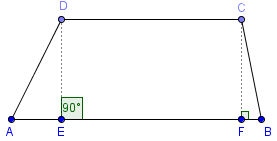Midline and Midsegment of Trapezoid and Triangle

The parallel sides of the trapezoid, are called bases (AB and CD) and the ones that are not parallel are called legs (AD and BC).
If the legs are equal in length, the trapezoid is called isosceles.
DE and CF are altitudes.
Midline of Trapezoid

A line that joins the midpoints of the sides that are not parallel is called a midline(or a midsegment) of trapezoid.
The line MN is the midline of ABCD. And the segment MN is the midsegment of ABCD.
AM = MD
BN = NC
The midline of a trapezoid is parallel to its sides.
In our case - MN || AB || DC.
Theorem 1:
Theorem 2:
In other words:
$\overline{MN} = \frac{\overline{AB} + \overline{DC}}{2}$
Midsegment of a Triangle
The segment that joins the midpoints of two sides of a triangle is called a midsegment of a triangle.
It is parallel to the third side and its length is half as long as the third side.
Theorem: If a line segment crosses the middle of one side of a triangle and is parallel to another side of the same triangle, then this line segment halves the third side.

$\overline{AM} = \overline{MC}$ and $\overline{BN} = \overline{NC}$ =>
$MN || AB$
$\overline{MN} = \frac{\overline{AB}}{2}$
Application of the properties of the midsegments
Divide a segment into equal segments without measuring.
Assignment: Divide a given segment $\overline{AB}$ into 5 equal segments without measuring.
Solution:
Let p be an arbitrary ray with origin A and that does not lie on AB. We draw consecutively five equal segments on p.
$\overline{AA_1} = \overline{A_1A_2} = \overline{A_2A_3} = \overline{A_3A_4} = \overline{A_4A_5}$
We connect A5 with B and draw lines through A4, A3, A2 and A1 that are parallel to A5B.
They cross AB at points B4, B3, B2 and B1, respectively. These points divide the segment $\overline{AB}$ into five equal segments.
Indeed, from the trapezoid BB3A3A5 we see that $\overline{BB_4} = \overline{B_4B_3}$. By the same way, from the trapezoid B4B2A2A4, we obtain $\overline{B_4B_3} = \overline{B_3B_2}$

While from the trapezoid B3B1A1A3,
$\overline{B_3B_2} = \overline{B_2B_1}$.
Then, from B2AA2, it follows that $\overline{B_2B_1} = \overline{B_1A}$. We finally get:
$\overline{AB_1} = \overline{B_1B_2} = \overline{B_2B_3} = \overline{B_3B_4} = \overline{B_4B}$
It is clear that if AB must be divided into another number of equal segments, we must project the same number of equal segments on p. Then we proceed the same way.

 MENU
MENU